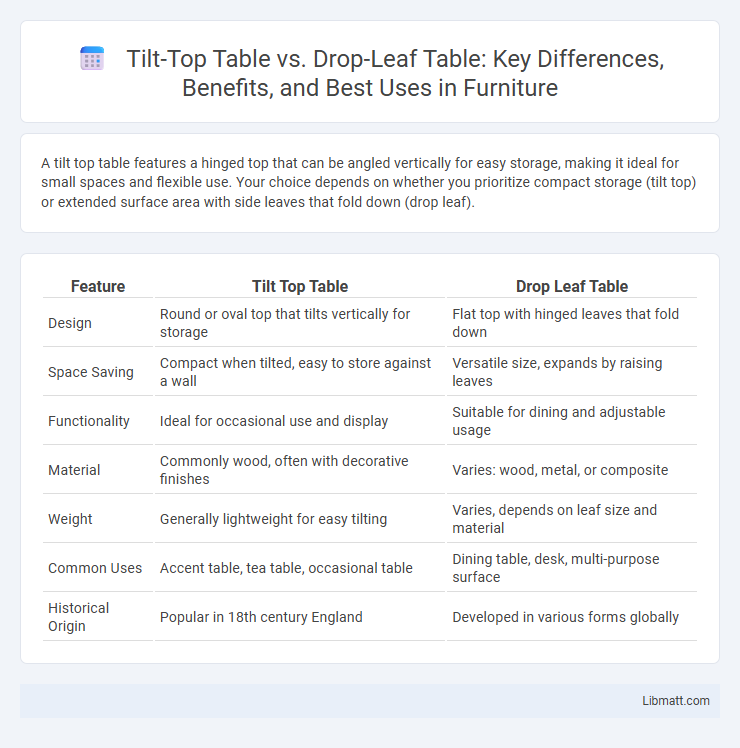A tilt top table features a hinged top that can be angled vertically for easy storage, making it ideal for small spaces and flexible use. Your choice depends on whether you prioritize compact storage (tilt top) or extended surface area with side leaves that fold down (drop leaf).
Table of Comparison
| Feature | Tilt Top Table | Drop Leaf Table |
|---|---|---|
| Design | Round or oval top that tilts vertically for storage | Flat top with hinged leaves that fold down |
| Space Saving | Compact when tilted, easy to store against a wall | Versatile size, expands by raising leaves |
| Functionality | Ideal for occasional use and display | Suitable for dining and adjustable usage |
| Material | Commonly wood, often with decorative finishes | Varies: wood, metal, or composite |
| Weight | Generally lightweight for easy tilting | Varies, depends on leaf size and material |
| Common Uses | Accent table, tea table, occasional table | Dining table, desk, multi-purpose surface |
| Historical Origin | Popular in 18th century England | Developed in various forms globally |
Introduction to Tilt Top Tables and Drop Leaf Tables
Tilt top tables feature a hinged tabletop that pivots vertically, allowing easy storage and space-saving in compact areas. Drop leaf tables have hinged sections on one or both sides that fold down, providing adjustable surface area to accommodate varying needs. Both designs optimize functionality in small living spaces by combining practicality with traditional furniture styles.
Design and Construction Differences
Tilt top tables feature a hinged tabletop that pivots vertically to save space and enhance portability, often supported by a tripod or pedestal base for stability when in use. Drop leaf tables incorporate hinged sections on one or both sides of the main tabletop, which can be lowered or raised to adjust the table's surface area, typically supported by swing-out brackets or legs. The construction of tilt top tables emphasizes a compact footprint and ease of storage, while drop leaf tables prioritize flexible surface dimensions suited for varying room layouts.
Space-Saving Features Compared
Tilt top tables feature a hinged tabletop that tilts vertically for compact storage against walls, maximizing floor space in small rooms. Drop leaf tables have hinged sections on either side that fold down to create a smaller footprint or extend for additional surface area, providing flexible dining or workspace options. Both designs prioritize space-saving but cater to different needs: tilt tops excel in narrow spaces, while drop leaf tables offer variable table sizes.
Versatility and Functionality
Tilt top tables offer superior versatility by allowing you to easily fold the tabletop vertically, saving space and providing quick access for storage or transport. Drop leaf tables enhance functionality with hinged leaves that can be extended or collapsed, adapting seamlessly to different room sizes and seating needs. Both designs optimize space management, but your choice depends on whether you prioritize portability (tilt top) or flexible dining capacity (drop leaf).
Style and Aesthetic Appeal
Tilt top tables offer a classic, elegant style often associated with antique or vintage decor, featuring a single pedestal base and a top that tilts vertically for space-saving storage. Drop leaf tables provide versatile design options, from traditional to modern aesthetics, with hinged leaves that fold down to create a more compact footprint or extend for additional surface area. Your choice depends on whether you prefer the sculptural, decorative appeal of tilt top tables or the functional, adaptable look of drop leaf tables in your living space.
Ease of Use and Adjustability
Tilt top tables offer superior ease of use with a simple mechanism that allows the tabletop to pivot vertically, providing quick and effortless space-saving options. Drop leaf tables feature hinged leaves that fold down or extend horizontally, requiring slightly more effort to adjust but allowing for flexible surface area customization. Both designs enhance adjustability, but tilt top tables generally provide faster, more intuitive access for users needing rapid transitions.
Durability and Material Choices
Tilt top tables often feature solid hardwoods like oak or mahogany, enhancing durability and resistance to wear, while drop leaf tables typically use a mix of hardwoods and veneers, which may affect longevity. Your choice depends on the intended usage; tilt top tables offer robust stability with a permanent base, whereas drop leaf tables provide flexible space-saving options but may have more moving parts prone to wear. Prioritizing quality materials such as hardwood and sturdy hardware ensures better durability for either table style.
Ideal Room Settings and Uses
Tilt top tables are ideal for smaller rooms or multifunctional spaces where floor space needs to be quickly freed up, making them perfect for cozy living rooms or compact dining areas. Drop leaf tables suit flexible dining settings where occasional expansion is necessary, fitting well in kitchens or dining rooms that host varying guest numbers. Your choice depends on whether you prioritize ease of storage with a tilt top or adjustable surface size with a drop leaf table.
Pros and Cons of Tilt Top Tables
Tilt top tables offer space-saving benefits by allowing the tabletop to be angled vertically, making storage against walls easy and efficient. They provide versatility for small living spaces but may lack the stability of fixed tables, as the tilting mechanism can sometimes loosen over time. Unlike drop leaf tables, tilt tops do not expand the surface area but prioritize compact storage and portability.
Pros and Cons of Drop Leaf Tables
Drop leaf tables offer space-saving versatility with hinged sections that can be folded down when not in use, making them ideal for small rooms or flexible layouts. They provide easy expansion for additional seating but may lack the sturdiness of fixed tables, with potential wobbling issues when leaves are extended. Drop leaf tables often require manual setup and can have weight limitations on the leaves compared to tilt top tables, which fold vertically and offer a more compact storage option.
tilt top table vs drop leaf table Infographic

 libmatt.com
libmatt.com